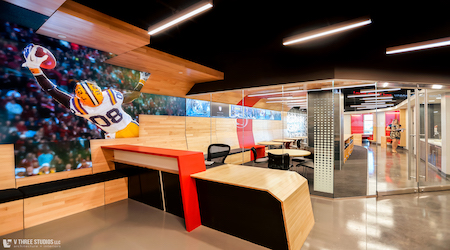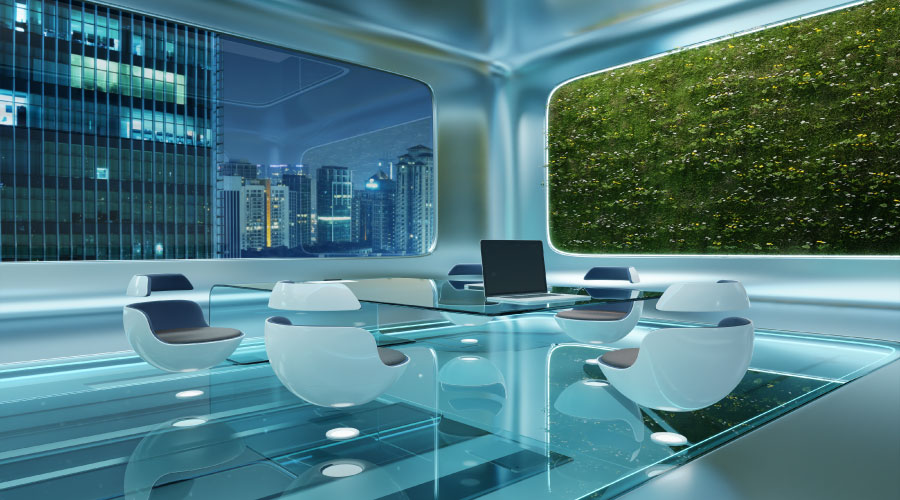3 Workplace Design Trends Shaping Tomorrow's Offices
Keep these trends in mind to ensure your space doesn't become obsolete.
By Chris Mrozewski and Chuck Huss
A well-designed workplace benefits almost everyone involved —employees come to work feeling more valued and willing to contribute, employers are able to maximize productivity and efficiency among departments, and facility managers have fewer maintenance-related headaches to deal with. This seems obvious at first pass, but the difficulty for facility managers is finding the ideal design solution for the specific type of company occupying a given space. A simple online image search will yield hundreds of photos of shiny, futuristic office interiors from large, successful companies, but what are the underlying principles that cause these spaces to be designed the way they are? How does the built environment position that individual company for growth and help achieve its business goals?
Fortunately, there are three basic design trends underlying almost every modern office environment, regardless of the industry or particular business model of the company. In no particular order, these trends are:
• Encouraging creativity among employees.
• Integrating useful technology into the built environment.
• Placing a greater emphasis on employee wellness.
The goal of implementing these strategies may be to outperform competitors through creative product offerings or solutions, to use technology to help employees more efficiently perform job-related tasks, or to retain valuable talent by ensuring employee health and job satisfaction. Although almost universal in modern workplace design, these trends are filtered through the lens of each individual company’s unique culture and identity, often with widely varying results. Across the board, good workplace design should always aim to achieve a company’s goals while adhering to its internal culture, regardless of whether the office is owned by a cutting-edge technology startup, a more traditional firm, or any type of company in between.
1. Encouraging Employee Creativity
The first trend is perhaps the hardest to measure: encouraging employee creativity through conscious design choices. The benefits of a company’s employees being consistently creative are well-known but often difficult to realize. By eliminating silos and encouraging collaboration among internal departments, employees are encouraged to think outside the box and come up with new solutions to existing problems rather than simply compete with what other companies are doing. This creates a company culture in which individuals with the highest drive to succeed are allowed to flourish rather than being forced to conform to industry norms. This then ultimately results in improvements to the company’s bottom line once customers and prospective clients take notice of the increasingly valuable solutions offered as a result of this boost in creativity.
Designing spaces to foster employee creativity can be approached differently depending on the industry, but the general idea is to eliminate silos between various departments and encourage a spirit of creativity and collaboration. Here are some ways to do that:
• Lowering furniture walls. Reducing visual barriers such as cubicles between employees promotes a more open and connected workplace environment that encourages employees to share ideas more frequently.
• Placing dissimilar departments closer to each other. This may seem counterintuitive, but the intersection of differing opinions and approaches among various internal departments may lead to more out-of-the-box solutions to common problems.
• Replacing solid walls with transparent glass. In addition to looking sleek and modern, this design choice increases transparency within an office, both literally and figuratively. Lower-level employees are given a chance to see their superiors at work rather than feeling perpetually disconnected from them.
• Moving management staff workspaces out among other employees. Continuing with the trend of connecting upper-level employees with their subordinates, management staff are increasingly being placed among other employees to encourage a sense of camaraderie and team spirit rather than the traditional corporate hierarchy.
• Converting more private office space to communal collaborative space. As employee connectivity becomes increasingly valued, the first spaces within the workplace being sacrificed are the large, private corner offices of yesterday. In their place stand communal meeting areas designed to promote spontaneous collaboration and a team mentality among employees.
Below is one example of a real-world project incorporating this open office aesthetic. This workplace was designed for a client in the finance industry whose office previously featured high walls, a darker color scheme, and a constricted network of walkways rather than open common spaces. The newly designed office space provides a lighter, more open environment with increased focus on shared meeting areas and uninterrupted lines of sight across the entire floor.

Caption: An executive office is integrated into the rest of the floorplan using transparent glass walls.

Caption: A centrally-located meeting room has clear lines of sight to nearby employee workstations
2. Integrating Useful Technology Into the Built Environment
For companies whose employees perform their core job functions using technology — which at this point is almost every company — integrating it into the built environment is a key component of workplace design. Where technology was once added during the final stages of construction, it is now so integral to the functionality of most offices that it affects almost every decision throughout the design/build process.
Some examples of these specific design decisions include:
• Reducing paper storage. Office space that previously would have been dedicated to paper storage is now being used for other purposes.
• Rethinking employee workstations. Modern workstations are being designed to accommodate the constantly changing technology needed for day-to-day purposes. Along with the advent of technology integration comes an increasingly diversified set of responsibilities for each employee, given that traditional business practices are now much more efficient. This results in each employee needing increasingly customized workspaces given their specific roles. The design fix for this situation is planning flexibility into each employee workstation so that the office does not need to be continually redesigned for each new iteration of technology or change in a person's job functions.
• Connecting employees both in and out of the office. Flexible meeting space has become a higher priority for most companies due to the fact that many employees now have the option to work remotely and use technology to interface with their colleagues in the office. This has resulted in the design of specialized meeting rooms allowing for phone calls in addition to video conferencing, file sharing, and more.
• Improving efficiency with integrated technology. Smart lighting and sensors can significantly increase a building’s efficiency, thus lowering utility costs. An example is the ability to monitor heating and air conditioning levels on every floor of a building, examine the collected data, and then optimize the system for optimal energy performance. This kind of technology is becoming increasingly common and has even been adopted as a code requirement in many U.S. cities.
A recently completed project that serves as a good example of technology integration can be seen below. In newly renovated offices for a media company, great emphasis is placed on the presence of technology not only to represent the company’s culture but also to assist employees in completing their daily tasks.

Caption: A greeting/reception area features prominent integrated display screens as well as a desk with all necessary electronic connections.

Caption: A conference room features dual display screens, a camera, and a touchpad to control a remote video conferencing system.
3. Placing Greater Emphasis on Employee Satisfaction
A third underlying trend driving modern workplace design is an increasing emphasis on employee satisfaction, including employee wellness. Regardless of the type of company, it is more important now than ever to focus on employees as a means of retaining talent and reinforcing company culture. As with the other design trends, this can be expressed differently depending on the type of work a company does, but there are a few common threads among most spaces. They include:
• Enhancing amenities. It is a well-established fact that happy employees perform their work better and more consistently, and modern office design has responded accordingly. Enhanced amenities like coffee bars, game areas, massage rooms, and more are often designed into workplaces from the beginning stages of a project.
• Providing ergonomically designed workspaces. While workspaces need to be designed specifically to accommodate a variety of technology, it is also increasingly important that they be engineered ergonomically to prevent employee fatigue and discomfort as well as helping workers perform their job functions easily and efficiently. This is accomplished with adjustable height furniture as well as creative arrangements of the components in each employee workspace. Beyond the workspaces themselves, companies are offering multiple settings where employees can choose to work, including break areas for cafe-style working, collaborative areas, and the option to work from home or another remote location. This variety of options is intended to promote employee wellness as well as boosting creativity and efficiency.
• Increasing the size of break and recreation areas. Beyond adding extra amenities for employees to enjoy, designers are now increasing the physical size of the space allocated for these resources and activities. Larger break rooms, lunch areas, recreation rooms, and other facilities are being added in the space previously occupied by paper storage or large server rooms. Furthermore, these spaces are now more centrally located and have more access to natural light, as opposed to being tucked away in building corners or basements like more traditional break rooms were.
All three of these trends reflect an increased focus on employee job satisfaction and retention. Given the present reality of workspaces being shared on social media, a booming economy with plenty of job availability, and stronger regulations in regards to workers’ rights, it isn’t surprising that nearly every contemporary workplace is designed to prioritize these basic trends.
Chris Mrozewski and Chuck Huss are designers with V Three Studios.
Related Topics:
















